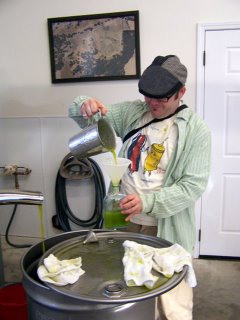
Me bottling the olive oil pressed from the olives I and a group of 17 others gathered in an hour and a half: 380 pounds.
The Bite
After waking up, breaking fast, and taking pictures, I discover an olive on the rocks near the milling equipment that had somehow hidden itself from Josh and Rich's eye during the hose down of the equipment. Unlucky olive. I had been waiting to bite into an uncured olive for... well, years. I crave to connect with food, and comprehensive knowledge wouldn't be comprehensive without trying everything.
After the bite, the level of astringency is what I find separates the taste of an untreated olive from the bitterness of a good olive oil, howver robust that oil may be. So many of the flavor components in that bitterness are water-soluble that if the water of the olive is still present, only unpleasantness will result. What I find so remarkable are the overlays of similarity; underneath all that nasty, the interesting flavors, notes, and sensations can be recognized. I can see why we as culinary machines were unwilling to leave the olive alone.
My next desire is to taste straight olive water--I wonder if it could be used like bitters? I wonder if I could sugar it up and let it ferment and what that would taste like?
Jovian Olive Oil Making
For the apron-bedecked Roman God Jove, sitting in his kitchen on Jupiter, making olive oil is easy. Wait for a hot day, smash a grove of olive trees in a mortar and pestle, let everything settle, pour the oil off of the top; it shouldn't take long.
If it's a cold day, you'll have a hard time getting olive oil out of a bottle, much less an olive, since olive oil will turn solid on a cold December Earth day. And on Earth the gravity isn't helping speed up the separation of the oil, water, and fruit solids. [Number One Rule when comprehending olive oil: Never forget an olive is just a fruit.] But I could toss all that mashed olive in a front loading dryer, turn it on for a while and then suck the oil out with a straw, because the dryer will apply enough centrifugal force with its spin to act like Jupiter's gravity (if you spin it fast enough). Add some bells and whistles to make it as efficient as possible at applying centrifugal force to mashed olives and Josh & Rich are as good as Roman gods in the kitchen.
Friday
After Robbie and Sarah and I woke up we had quick, light breakfasts of English muffins or toast (mine drizzled with the Orange Pasolivo from the night before--tasty). Our first task that day was to bring empty bottles to the mill in preparation for the Miller's Lunch that day. Joeli had two major events planned for the weekend. The one today was for about 16 people who had paid Willow Creek for the opportunity to pick olives, watch them go through the mill, and bottle and label for themselves 3 200 milliliter bottles of Olio Nuovo. If this sounds a little Tom Sawyeresque, painting fences for Joeli, Catalino & crew, keep in mind it also included a catered lunch of
appetizer: 3 cheeses (truffle cheese, la tur, abbaye de ????), walnuts, pistachios, dates, citrus fruit, turkey pate, and cookie thick flatbread.
soup: butternut squash drizzled with Lime Pasolivo
roasted brussels sprouts and cauliflower
shortribs on creamy polenta
apricot rustic italian pie
with an open scotch bar before the dessert.
About 10am the group had gathered and we trekked up to a part of the ranch with Mission and Manzanilla olives. Willow Creek has two blends of extra virgin olive oil: one blend is the signature Pasolivo blend with five Tuscan varietals plus a smidgen of Kalamata; the other is California Blend with Mission and Manzanilla. Both taste amazing. Friday was a hefty learning day for me, listening, taking photographs, and encountering my first olive trees.
Olive Oil 101.03
Olives and avocados (and a couple of other more obscure fruits to the American palate) are anomalies in the realm of culinary fruits. Instead of storing energy in the form of carbohydrates (sugars or starches), olives and avocados store it in the form of fats. You'll best understand what makes a good olive oil if you understand that nothing but containing oil separates an olive from a cherry or a peach or a plum. Take a handful of cherries, squeeze really hard, and you'll have water and sugar (in a water solution) in rivulets of red. In addition to that you'll have all those chemicals which make a cherry look like a cherry and taste like a cherry and an olive taste like an olive.




